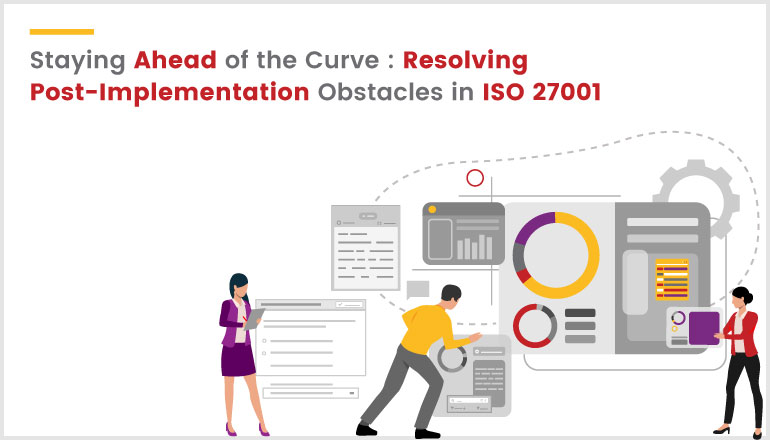In an age where digital data has become the lifeblood of organizations, safeguarding sensitive information is more crucial than ever. Implementing ISO 27001, a globally recognized information security standard, is a substantial step toward fortifying an organization's data protection measures. However, the journey doesn't end with implementation. It is an ongoing process that requires regular attention and action.
Organizations need to renew their ISO 27001 certification every three years. In between, they must undergo two surveillance audits per year. Companies must regularly review their compliance controls and develop new ones to handle emerging risks as their organization grows.
It is important to remember that ISMS is not just for ISO 27001 certification day. It is a living system that must be maintained on a day-to-day basis. The more companies can integrate ISMS into their regular business operations, the smoother the maintenance process. This will help to reduce the number of "peaks" and "troughs" that companies experience when they have to scramble to prepare for audits.
In this blog post, we will discuss some of the most common post-implementation obstacles that organizations face and how to resolve them.
Lack of management commitment
One of the biggest challenges to maintaining an effective ISO 27001 program is a lack of management commitment. Without the support of senior management, it can be difficult to get the resources and buy-in necessary to keep the program running smoothly. To overcome this obstacle, it is important to get buy-in from top management from the start of the implementation process. This will help ensure that the program is properly funded and supported on an ongoing basis.
Changes to the organization
Many companies, particularly startups, are constantly evolving and adapting their processes as they grow, so too do their security needs. It is important to be prepared to adapt the ISO 27001 program to reflect these changes. This may involve updating the risk assessment, developing new policies and procedures, or conducting training for new employees. To stay ahead of the curve, it is important to conduct regular reviews of the ISO 27001 program and make necessary changes as needed.
Integration with Business Process
Striking a balance between robust security measures and seamless business operations can be a challenge. Even the best-implemented ISO 27001 programs can experience non-compliance issues. This may be due to human error, system failures, or changes to the organization's environment. It is important to have a process in place for quickly identifying and resolving non-compliance issues. This will help to minimize the impact of any security breaches that may occur.
.png)
Maintenance of Documentation
After successfully implementing ISO 27001, organizations often encounter the challenge of maintaining their documentation. Policies, procedures, risk assessments, and incident reports must be continuously updated to reflect changes in technology, regulations, and organizational structure. Establishing a clear document control process and assigning responsible personnel to review and update documents can mitigate this challenge. Regular audits to ensure the accuracy and relevancy of documented information can prevent documentation from becoming outdated.
Employee Awareness and Training
Maintaining a high level of employee awareness and understanding of information security practices is vital. Regular training sessions, workshops, and communication efforts are necessary to ensure that employees comprehend their roles and responsibilities regarding information security. These initiatives also help in making the ISMS an ingrained part of the organization's culture. Interactive training materials, real-world examples, and periodic security drills can significantly enhance employee engagement and awareness.
Resource constraints
Many organizations face resource constraints that can make it difficult to maintain an effective ISO 27001 program. This may be due to limited budget, staff, or time. To overcome these challenges, it is important to prioritize the most critical security controls and focus on those areas first. It is also important to make use of automation and other tools to help streamline the program and free up resources for other tasks.
Third-Party Management
In today's interconnected business landscape, third-party vendors play a significant role. Managing the security risk, they introduce is a challenge. Establishing a well-defined vendor management program, regular audits, and assessments of third-party security controls should be performed to ensure they meet your organization's standards.
Conclusion
Implementing ISO 27001 is a significant achievement, but it is just the beginning. Organizations must continue to proactively address challenges from leadership commitment to business processes, documentation maintenance, employee training, continuous improvement, compliance, and supplier management to stay ahead of the curve and maintain a robust information security posture. This commitment ensures that sensitive data remains protected and the benefits of ISO 27001 are sustained over time.
We, Briskinfosec, are mastering seamless ISO 27001 implementation. Our expert solutions ensure smooth post-implementation journeys, conquering obstacles from integration hiccups to resource constraints. Beyond compliance, we empower you to grasp the significance of adhering to industry standards. Stay ahead of us on the path to robust information security.



